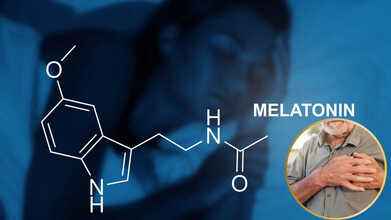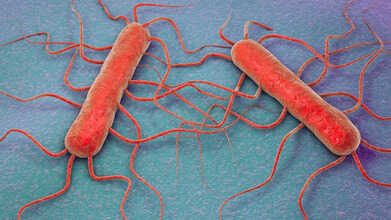- Health Conditions A-Z
- Health & Wellness
- Nutrition
- Fitness
- Health News
- Ayurveda
- Videos
- Medicine A-Z
- Parenting
- Web Stories
Do Blue Light Glasses Actually Protect Our Eyes?

Credits: Canva
Have you come across blue lenses? Every time I go to get my new glasses made, I am always asked whether I want the blue lenses. But what exactly are these blue lenses? I am told that it protects your eyes from the blue light that comes from our phone and computer screens. With the rise of digital device and spending most hours of our day on screen, concerns over blue light exposure have grown significantly. This is why blue light glasses and lenses have been introduced to help mitigate potential harm. But the question is: are they really that effective or are there other ways to protect your eyes from blue light-related symptoms like eye fatigue and dry eye?
Let’s break it down.
What is Blue Light?
Blue light is a type of visible light, which has a shorter wavelength of 415 to 455 nanometers, this is what gives it more energy than other light types. The source is not artificial, but also when we look up at the blue sky.
However, for years, humans were exposed to this blue light only during the hours when sun was up. This is why our brain trained us to be active and alert and keep our bodies up when we see that light. However, with phones and computer screens which emit blue light all the time, leaves our body and brain confused. It also interferes in the circadian rhythm of the body.
Too much blue light during the day can lead to:
- Eye fatigue: Prolonged screen time can make your eyes feel strained.
- Dry eye: Staring at screens reduces your blinking rate, causing dryness.
- Sleep disruption: Blue light interferes with melatonin production, a hormone crucial for sleep, leading to poor sleep quality.
What Are Blue Light Glasses?
Blue light glasses are designed to filter out blue light wavelengths before they reach your eyes. The idea is that this filtering minimizes the harmful effects of prolonged exposure, like eyestrain, dry eye, and disrupted sleep patterns.
But do they actually work?
The evidence is mixed.
The American Academy of Ophthalmology does not currently endorse blue-light-filtering glasses for reducing computer-related eyestrain, suggesting more research is needed.
- A 2023 study, titled Blue-Light Filtering Spectacle Lenses: Optical and Clinical Performances, found no significant short-term benefits of blue-light-filtering lenses in reducing visual fatigue compared to regular lenses.
- A 2017 review of clinical trials, published in the National Library of Medicine showed limited evidence supporting blue-light-blocking glasses for eye health and dry eye prevention.
- Some users report benefits like reduced glare and improved screen visibility, but studies like one funded by Swiss Lens Laboratory Ltd. suggest potential bias.
Practical Tips to Reduce Blue Light Exposure
You don’t need special glasses to protect your eyes from blue light. Simple lifestyle changes can make a big difference:
- Follow the 20-20-20 rule: Every 20 minutes, look at something 20 feet away for 20 seconds. This reduces eye strain.
- Take screen breaks: Step outside for a walk, leaving your devices behind. This not only gives your eyes a break but also boosts vitamin D levels.
- Dim your lighting: Use softer lighting at home, and consider red light for nightlights, as it’s less disruptive to your sleep cycle.
- Adopt screen-free hobbies: Activities like reading, knitting, or cooking can help you reduce screen time.
- Limit screens before bed: Avoid devices for 2–3 hours before sleeping to improve sleep quality.
- Use lubricating eye drops: If dry eye is a problem, over-the-counter drops can provide relief.
What Are the Side Effects of Blue Light Exposure?
Prolonged exposure to blue light can cause:
- Computer Vision Syndrome: Symptoms include eyestrain, dry eye, blurred vision, and headaches.
- Sleep disturbances: Reduced melatonin production disrupts your circadian rhythm, impacting your ability to fall and stay asleep.
- Stress sensitivity: Poor sleep due to blue light exposure can increase stress levels, as REM sleep is essential for mental relaxation.
When to See a Doctor
If you experience persistent or severe symptoms, consult an eye doctor. Warning signs include:
Frequent or long-lasting eyestrain
Chronic dry eye symptoms
Noticeable decline in vision quality
Consistently blurred vision
Could Long-Term Melatonin Use Be Silently Harming Your Heart? Here’s What Experts Say

Credits: CANVA
Long-term use of melatonin, a popular over-the-counter sleep supplement, has been linked to a higher risk of heart failure and early death in adults with insomnia, according to new research published on Monday.
While the findings don’t show that melatonin directly causes heart problems, experts suggest that the need to rely on it regularly to fall or stay asleep could point to hidden heart-related issues.
What Is Melatonin?
Melatonin is a naturally occurring hormone that plays a key role in regulating sleep. Often called the body’s “sleep hormone,” it helps control the circadian rhythm, which is the internal clock that tells us when to sleep and wake up. The pineal gland in the brain produces melatonin, but many people now turn to melatonin supplements to improve sleep quality.
According to the Cleveland Clinic, these supplements are often marketed for managing insomnia or jet lag. While melatonin can help set a natural sleep cycle, it is not meant to diagnose, treat, or prevent any medical condition. In several countries, including the United States, it is available over the counter without a prescription.
Can Melatonin Lead To Heart Issues?
As over-the-counter supplements are not strictly regulated, melatonin products can vary widely in their concentration and purity. This inconsistency may contribute to different long-term effects on the body.
To assess the potential risks, researchers examined health data from more than 130,000 adults diagnosed with insomnia who had used melatonin for at least a year. They compared these individuals with others who also had insomnia but did not take the supplement.
The results were concerning. People who used melatonin for 12 months or longer showed about a 90 percent higher risk of heart failure over a five-year period than those who did not.
“Melatonin supplements are widely considered a safe and ‘natural’ solution for better sleep, so it was striking to see such strong links to serious health outcomes even after accounting for other risk factors,” said study author Ekenedilichukwu Nnadi, as quoted by The Independent.
Heart failure occurs when the heart cannot pump enough oxygen-rich blood to meet the body’s needs, which can be life-threatening. The study also observed a similar rise in heart failure risk among people who had at least two melatonin prescriptions filled 90 days apart. In fact, melatonin users were found to be 3.5 times more likely to be hospitalised for heart failure compared to non-users, according to the research, which was presented at the American Heart Association’s 2025 Heart Disease and Stroke Statistics meeting but has not yet been peer-reviewed.
So, Is Melatonin Safe To Consume?
To understand the implications, we spoke with Dr. Khushboo Hatekar, Assistant Professor of Neurology at Dr. D.Y. Patil Medical College, Hospital and Research Centre, Pimpri, Pune. She explained that long-term dependence on melatonin often points to underlying conditions such as cardiovascular stress caused by chronic insomnia.
“Insomnia itself raises blood pressure, stress hormones, and inflammation, all of which strain the heart. So, prolonged melatonin use may serve as a signal of hidden heart issues rather than being the direct cause,” she said.
Dr. Hatekar also cautioned against taking melatonin regularly without medical supervision. “Most guidelines recommend melatonin for short-term use, mainly for jet lag or specific sleep disorders,” she added. However, current evidence highlights the need for more detailed clinical studies to determine whether extended use poses a cardiovascular risk.
While short-term use of melatonin appears safe for most people, taking it continuously for a year or longer may increase the likelihood of heart failure and related complications. Both patients and doctors should carefully weigh the benefits and monitor heart health if the supplement is used over an extended period.
Having Difficulty Concentrating? Experts Say ‘Popcorn Brain’ Might Be To Blame — All You Need To Know About This Syndrome

Credits: Gemini/Canva
Do you struggle to concentrate and find it hard to focus on one task for more than a few minutes? You might be dealing with what psychologists are calling “popcorn brain”. The name may sound lighthearted, but experts say the condition is real and growing more common.
With constant use of smartphones, laptops, tablets, and televisions, people, especially teenagers and young adults, are spending most of their waking hours in front of screens. This nonstop exposure is leading to what’s now known as Popcorn Brain Syndrome, a modern problem that is affecting focus, attention span, and emotional balance.
To understand the condition better, we spoke with Dr. Astik Joshi, Child, Adolescent, and Forensic Psychiatrist at Veda Clinic, Rohini, and Fortis Hospital, New Delhi.
What Is Popcorn Brain Syndrome?
Popcorn Brain Syndrome refers to a state where the brain becomes so used to fast, constant digital stimulation that it struggles to adjust to slower, real-world activities. Much like popcorn rapidly popping in a microwave, the brain starts craving constant bursts of new information. When the pace slows down, like during reading or in-person conversations, the mind becomes restless, impatient, or easily bored.
According to Dr. Joshi, “Popcorn brain syndrome isn’t a formal medical term or diagnosis. It’s a phrase used to describe how our minds can’t stay still and keep jumping from one thought to another, just like popcorn pops when exposed to heat.”
However, now, the term “popcorn brain” has been gaining attention in mental health circles. It was first introduced by David M. Levy, Ph.D., a computer scientist at the University of Washington, who described it as a state where people become so used to multitasking online that real life feels too slow and uninteresting.
The syndrome is not limited to social media enthusiasts or office workers glued to their emails, the constant pings and alerts from our devices make this phenomenon relatable to almost everyone.
How Does Popcorn Brain Syndrome Affect Your Brain?
Popcorn brain can cause difficulty focusing, frequent distraction, restlessness, and poor time management. Dr. Joshi explained that screen time creates a continuous flow of stimulation that makes our thoughts and emotions jump around, causing mental and emotional unease.
“This constant mental restlessness can have a negative impact on teenagers and young adults,” he said. “Their brains are still developing, and they haven’t yet built full control over their emotions and thoughts. Continuous exposure to screens interferes with healthy brain development and emotional regulation.”
According to a Healthline report, people experiencing popcorn brain also often complain of eye strain, headaches, blurred vision, and neck or shoulder pain, symptoms that overlap with computer vision syndrome (CVS) or digital eye strain.
Social Media Is to Blame for Popcorn Brain Syndrome
It is no surprise that social media plays a major role in this growing issue. Studies show that frequent use of phones, computers, and apps like Instagram can deeply affect our ability to concentrate.
One study published in Scientific Reports found that simply having a smartphone nearby reduced participants’ focus during attention tests. When their phones were switched off or placed out of sight, their concentration levels improved noticeably.
Another study by Stanford University showed that constantly shifting attention between screens—whether social media, phones, or TV, makes it harder to complete even simple tasks. In a 2022 survey conducted by King’s College London, half of adults in the U.K. admitted they felt their attention spans had shortened significantly over time.
How To Cure Popcorn Brain Syndrome?
To break the cycle of checking your phone every few minutes and give your brain a reset, Dr. Aditi Nerurkar, Harvard Physician, suggests four simple practices:
Limit your scrolling time
Restrict yourself to no more than 20 minutes twice a day for social media or non-essential phone use. “Use your phone only for calls, messages, and important emails,” she advises. To keep track, set a timer whenever you scroll.
Turn off notifications
Disable push alerts and pop-ups that tempt you to pick up your phone unnecessarily.
Keep your phone away while working.
Place your smartphone at least ten feet from your desk so you can focus on tasks. “Do the same at home, especially when you’re spending time with family,” says Dr. Nerurkar.
Don’t sleep next to your phone
Avoid placing your device on your bedside table. This prevents you from checking it right before bed or first thing in the morning. Let loved ones know to call if there’s an emergency, and keep the ringer on instead.
Dr. Nerurkar acknowledges that cutting down on screen time won’t be easy at first. To make it easier, replace the habit with small, grounding activities, like grabbing a notepad, fidget toy, or book, or simply walk around for a minute or two when you feel the urge to reach for your phone.
Listeria Pasta Outbreak: Worried About Infection? Here’s How To Stay Safe

Credits: Canva
Recalled Pasta Meals Listeria: A Listeria outbreak has taken six lives across 18 U.S. states in the past week, according to the Centers for Disease Control and Prevention (CDC). Two additional deaths have been reported in connection with a nationwide Listeria outbreak linked to recalled pasta salads and prepared meals, as noted by Emegypt.
From symptoms and affected products to safety measures, here is everything you need to know about the ongoing Listeria outbreak in the U.S. As the Listeria pasta outbreak spreads further, here’s a look at what it involves and how to prevent this potentially fatal infection.
What Is Listeria Pasta Outbreak?
The illness stems from a foodborne bacterial infection. When the bacterium Listeria monocytogenes contaminates food and causes poisoning, it is known as a Listeria outbreak, according to the Cleveland Clinic. The CDC has confirmed 27 Listeria cases across 18 states, with 25 hospitalizations so far. The source has been traced to Listeria monocytogenes found in precooked pasta meals produced by Nate’s Fine Foods Inc.
Listeria Recalled Pasta Meals: What Is Listeria Monocytogenes?
Listeriosis is a type of food poisoning caused by the bacterium Listeria monocytogenes, often referred to simply as “Listeria.” The Cleveland Clinic notes that most people experience mild symptoms such as fever, headache, nausea, or diarrhea. However, for individuals with weakened immune systems or those over the age of 65, the infection can lead to serious or even life-threatening complications.
Pregnant women are also at high risk since the infection can pass to the baby during pregnancy or delivery, leading to miscarriage, premature birth, or severe health problems for the newborn.
Listeria Outbreak: What Foods Have Been Recalled For Listeria?
According to USA Today, the following items have been recalled due to possible Listeria contamination:
- Marketside Grilled Chicken Alfredo (32.8 oz)
- Sprouts Farmers Market Smoked Mozzarella Pasta Salad
- Giant Eagle Smoked Mozzarella Pasta Salad
- Kroger Deli Bowtie and Penne Pasta Salads
- Scott & Jon’s Shrimp Scampi with Linguini Bowls (9.6 oz)
- Trader Joe’s Cajun Style Blackened Chicken Breast Fettuccine Alfredo (16 oz)
- Albertsons Store-Made Deli Pasta Salads
- Marketside Linguine with Beef Meatballs & Marinara Sauce (12 oz)
Listeria Outbreak: How To Prevent The Deadly Infection?
The U.S. Food and Drug Administration (FDA) recommends three key steps to reduce the risk of Listeria infection:
Maintain Proper Cooling Temperatures
Keeping food cold slows the growth of Listeria. If your refrigerator doesn’t have a digital temperature display, use a thermometer to check and adjust the settings. Place another thermometer in the freezer for accuracy.
• Your refrigerator should be at 40°F (4°C) or below.
• Your freezer should be at 0°F (-18°C) or below.
Consume Ready-to-Eat Foods Promptly
The longer leftovers or ready-to-eat meals stay in the refrigerator, the greater the chance that Listeria may grow. If a food item starts to smell, taste, or look unusual, it’s best to discard it.
Keep Your Refrigerator Clean
Regular cleaning helps prevent bacteria from spreading. Wipe spills as soon as they occur, this prevents Listeria from multiplying and contaminating other items. Wash shelves and walls with hot water mixed with mild dish soap, rinse thoroughly, and dry with a clean cloth or paper towel.
© 2024 Bennett, Coleman & Company Limited

